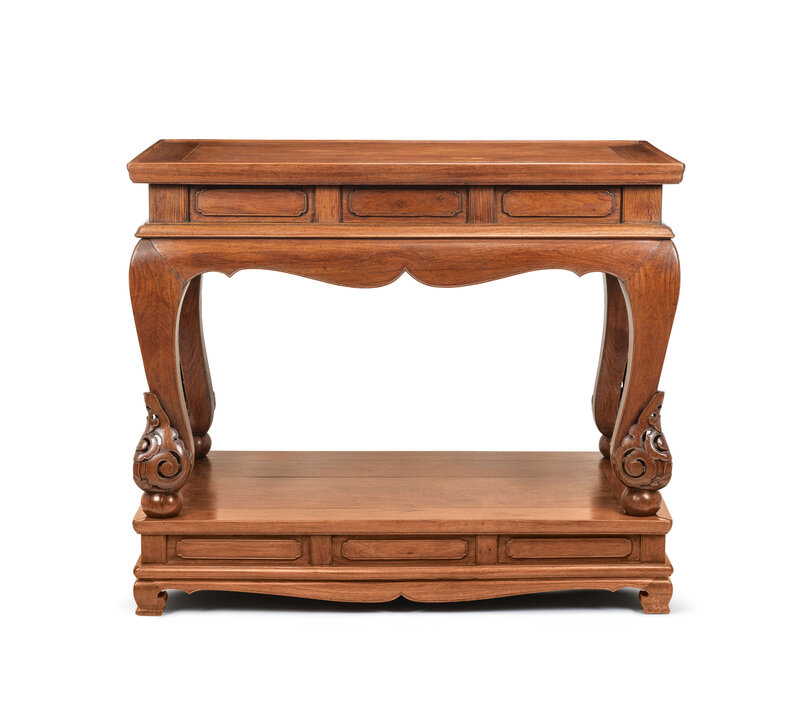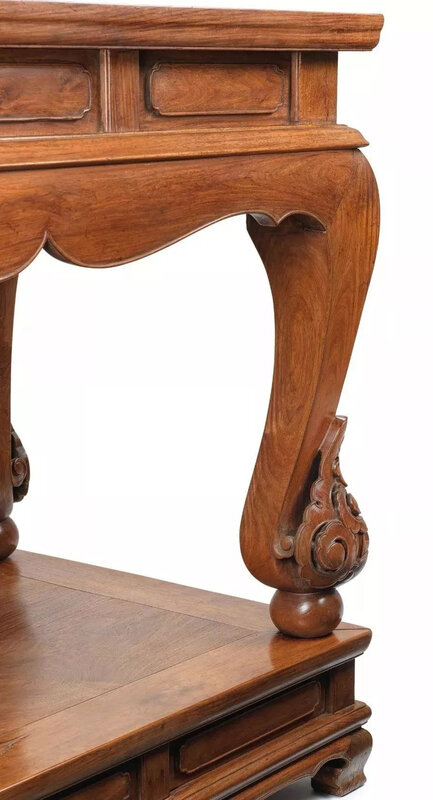A highly important and exceedingly rare huanghuali altar table, gongzhuo, Ming dynasty, second half of 15th century
Lot 2703. A highly important and exceedingly rare huanghuali altar table, gongzhuo, Ming dynasty, second half of 15th century; 39 in. (99 cm.) overall high, 41 in. (115cm.) long, 27 in. (69.8cm.) deep. Estimate HKD 6,000,000 - HKD 8,000,000. Price realised HKD 26,525,000. © Christie's Image Ltd 2019.
The two-panel rectangular top is set in a mitred frame with 'water-stopping' moulding and 'ice-plate' edge. The long sides of the high waist are decorated with three inset panels with raised begonia-shaped centres. The short sides with a similar panel and an incense stick drawer extending almost the entire length, above an unusual stepped and protruding moulding. The beaded ogee apron continuing into the massive cabriole legs terminating in upturned ends, each of stylised openwork in the form of an upturned leaf and resting on a ball foot. The detachable stand is echoing the table but without drawers and raised on short flanged cabriole legs.
Provenance: Sold at Sotheby’s New York, 18-19 October 1990, lot 614
The T.T. Tsui Collection
The Tsui Museum, acquisition no. MSF008
Sold at Christie’s New York, From Elegant Mansions: Fine Classical Chinese Furniture and Works of Art, 16 September 1998, lot 23.
Literature: Wang Shixiang, ‘Additional Examples of Classical Chinese Furniture-January 1992’, Chinese Furniture: Selected Articles from Orientations 1984-2003, Hong Kong, 2004, p. 101, fig. 7
Wang Shixiang, ‘Additional Examples of Classical Chinese Furniture’, Palace Museum Journal, 1993 Issue 1, Beijing, P.44-54
Sarah Handler, ‘Side tables, a Surface for Treasures and the Gods-May 1996’, Chinese Furniture: Selected Articles from Orientations 1984-2003, Hong Kong, 2004, p. 204, Fig.9
Sarah Handler, Austere Luminosity of Chinese Classical Furniture, Hong Kong, 2001, p. 230, no. 14.6.
Note: Altar tables are generally constructed of substantial proportions so that they serve a functional purpose in accommodating an array of displays including food and flowers, and ritual garnitures such as censers and vases made of varied materials. They were commonly placed in front of images of worship as ceremonial furniture and would have furnished a temple or a monastery. Sometimes such altar tables were placed at the centre of a reception hall or ancestral hall of a household. An early depiction of an altar table where it is shown placed in front of an arhat is illustrated on a Song dynasty handscroll, The Portraits of the Six Arhats, in the collection of the Beijing Palace Museum (fig. 1). The Palace Museum version is thought to be a copy of an earlier Tang dynasty painting by Lu Lengjia.
Formal and imposing side tables, often with additional everted flanges, were used as altar tables for certain households. However, these are very different from the present table which has a deliberate proportion and design. This type of altar tables would have been specifically commissioned for use in temples as suggested by Sarah Handler in Austere Luminosity of Chinese Classical Furniture, Hong Kong, 2001, p. 228. Altar tables of this type were referred to as gongzhuo in the 20th century by Beijing craftsmen. Unlike side tables, the present example has extraordinary distinctive features such as the elaborate design of the feet, a high waist with long drawers below the table top for storage of incense sticks, and is elevated on a stand or a floor stretcher. A closely related example displaying similar characteristics appears on a woodblock print of the Mudan ting ji, The Peony Pavilion, a revised edition by Zang Maoxun in the late Ming dynasty (fig. 2).
As altar tables are usually associated with ritual contemplation, the design is often more ornate and sumptuous, and thus in keeping with the ideals of honour and respect. The room where an altar table is placed can be assumed to be an important spiritual space where devotees could connect with the divine, and as such the decoration and proportions of the furniture used would more likely to have been reflected in grandeur of surrounding architectural elements. One of the most notable elements of the present table is the reticulated and layered scroll leaves at the end of the cabriole legs, each is supported on an integral spherical ball forming the foot. This combined technique of openwork and high relief carving is unique among all known examples of classical Chinese furniture to date, and demonstrates the finest carving skills of 15th century craftsmanship. It is interesting, therefore, to find similarly stylised scrolls along the top rail of a carved wood bell-stand in the Buddhist Faihai Temple in Beijing which was built in 1443 during the Ming dynasty Zhengtong reign (1436-1449) (fig. 3). This closely related floral design is also found as part of the decorative elements on the balcony in the Chengshi Sanzhai, ‘The Three Mansions of the Cheng’s’ in Huangshan city of Anhui Province (fig. 4). These grand mansions were constructed during the Chenghua reign (1465-1487) and belonged to Cheng Zhengmin (1446-1499), the deputy head of the Ministry of Rites - who by chance was the chief examiner of the famous scholar Tang Bohu (1470-1524) - and these buildings are preserved down the Cheng’s lineage.
On the present table, the sophisticated design of the feet and the cabriole legs in contrast to the plain and beaded aprons and high waist create a harmonious flow with simple but strong lines and curvatures. Each of the elegantly curved cabriole legs extends upward in a single timber that emerges to form an angled corner of the high waist. The elegance of the form provides a perfect balance in contour for the lower section where it is supported by a stand that is designed to match the waist. The high waist and the graceful undulations of the cusped apron are both distinctive features that have strong links to Buddhism. High waisted pedestal stands, xumizuo, were commonly placed in front of Buddhist images, whilst the arched outlines formed by the apron resemble the kunmen, the outlines to the openings of Buddhist caves and pagodas. For further discussion, please refer to Wang Shixiang, Connoisseurship of Chinese Furniture: Ming and Early Qing Dynasties, Hong Kong, 1990, vol.1, p.102-103.
The use of the beautifully grained huanghuali wood in this instance is fully utilised and integrated into the meticulous design. The whole table, including the liner of the drawers, is constructed entirely by the precious material huanghuali. Each of the curvilinear legs would have required substantial pieces of timber of at least 20cm x 20cm in cross section, as discussed by Wang Shixiang in ‘Additional Examples of Classical Chinese Furniture - January 1992', Chinese Furniture: Selected Articles from Orientations 1984-2003, Hong Kong, 2004, p. 101. Valuable timber of this enormous size was clearly available in 15th century China but undoubtedly with popular demand by later generations huanghuali wood became increasingly scarce.
The present table appears to be a unique example of a huanghuali altar table of the mid-Ming period, and a very rare type of furniture to be preserved especially with its original stand. Most of the known extant altar tables are of Qing dynasty in date, and are made of softwood and sometimes covered in lacquer. Compare with two very rare early altar tables, the first is a larger table in lacquered softwood dating to 13th-15th century in the C.L.Ma Collection (fig. 5) , which is illustrated in C.L.Ma Collection: Traditional Chinese Furniture From the Greater Shanxi Region, Hong Kong, 1999, p.148, no. 54. The second is a smaller table made of huanghuali, bamboo and nanmu with a comparable but more simpler design of the feet, dating to the late Ming dynasty, illustrated in Chinese Furniture: One Hundred and Three Examples from the Mimi and Raymond Hung Collection, vol. 1, New York, 1996, pp.132-133, no.45 (fig. 6).
Christie's. Glories of Buddhist Art, Hong Kong, 29 May 2019

/https%3A%2F%2Fprofilepics.canalblog.com%2Fprofilepics%2F1%2F0%2F100183.jpg)
/https%3A%2F%2Fstorage.canalblog.com%2F03%2F02%2F119589%2F96711876_o.jpg)
/https%3A%2F%2Fstorage.canalblog.com%2F11%2F31%2F119589%2F94773502_o.jpg)
/https%3A%2F%2Fstorage.canalblog.com%2F20%2F83%2F119589%2F94772815_o.jpg)
/https%3A%2F%2Fstorage.canalblog.com%2F26%2F72%2F119589%2F75604929_o.jpg)
/https%3A%2F%2Fstorage.canalblog.com%2F59%2F60%2F119589%2F26458628_o.jpg)






/image%2F1371349%2F20240426%2Fob_9bd94f_440340918-1658263111610368-58180761217.jpg)
/image%2F1371349%2F20240426%2Fob_844371_440162278-1658267648276581-39734064969.jpg)
/image%2F1371349%2F20240425%2Fob_78c699_440320998-1657454638357882-17494889713.jpg)
/image%2F1371349%2F20240421%2Fob_1dddd2_438878301-1654314112005268-81048289869.jpg)